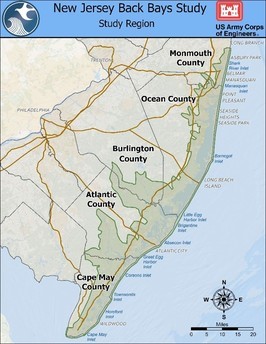PHILADELPHIA – The U.S. Army Corps of Engineers and the NJ Department of Environmental Protection Thursday released draft study results and a tentative plan for coastal storm resilience measures intended to protect the New Jersey shore from extreme weather and rising sea levels.
The USACE is soliciting public comment on the New Jersey Back Bays Coastal Storm Risk Management Study, which includes a tentatively selected plan for reducing the risk of storm and flood damage through storm surge barriers, cross-bay barriers and building elevations in the region that spans 950 square miles from Neptune to Cape May.
The study of measures to better protect this area of New Jersey from storm damage has been ongoing since 2016 and public comment on the study is now being sought by USACE and NJDEP.
While this study does not constitute a final or recommended plan of action, it provides critical storm risk information and a suite of options that will enable communities to evaluate and consider their preparedness.
Following public comment on this feasibility study, the USACE will consider potential revisions subject to many variables, including Congressional authorization, and the availability of federal, state, and local funding.
“To better protect New Jersey’s residents, communities, and economy, we must plan and prepare today for the climate change risks of tomorrow,” said DEP Commissioner Shawn M. LaTourette. “The Back Bays study integrates years of research and presents options for protecting areas of the Jersey shore from severe storms and flooding risks that threaten New Jersey today and that will worsen as our planet warms. As we continue to approach climate risks with the seriousness they demand, the Murphy Administration is grateful for the partnership of the U.S. Army Corps of Engineers and committed to engaging all New Jersey communities. We must seek and hear all voices as the Back Bay Study and other climate resilience plans take shape.”
“The potential solutions to back bay flooding are complex, but there is a clear need to consider and evaluate all options and that’s what the New Jersey Back Bays Study aims to do,” USACE Philadelphia District Commander Lt. Col. Ramon Brigantti said. “I want to thank NJDEP for their support and partnership as well as the many stakeholders we’ve collaborated with throughout the study process. We look forward to continuing that dialog in the coming months.”
Spurred by the devastation caused by Hurricane Sandy in October 2012, the Army Corps, in partnership with the NJDEP, has been conducting the feasibility study within the New Jersey Back Bay area, defined as the network of interconnected tidal water bodies located landward of the coastline in Monmouth, Ocean, Atlantic, Burlington, and Cape May counties. The study area includes approximately 950 square miles and nearly 3,400 miles of coastal waterway shorelines.
The objective is the investigation of coastal resilience solutions to reduce damages from coastal storm-related flooding that affects populations, critical infrastructure, property, and ecosystems. Engineering and economic analyses indicate the study area could experience $1.8 billion in average annual flood damages if no action is taken.
A tentative plan includes the following conceptual features:
- Storm surge barriers across the Manasquan Inlet, Barnegat Inlet, Great Egg Harbor Inlet
- Cross-bay barriers along Absecon Boulevard/Route 30 in Atlantic County and along an extension of 52nd Street in Ocean City.
- As many as 18,800 building elevations in vulnerable communities along Shark River, southern Barnegat Bay, Absecon Bay and the southern shore from Strathmere to Cape May Point.
Other non-structural measures, such as buyouts, and natural and nature-based features such as enhancing marshes or creating living shorelines, could be added to the plan in the next phase of the plan process.
The study is cost-shared by the NJDEP and the Federal government.
The public and stakeholders are invited to provide comments by Oct. 12.
To view the draft report, visit http://www.nap.usace.army.mil/Missions/Civil-Works/New-Jersey-Back-Bays-Coastal-Storm-Risk-Management/
The Army Corps will host virtual public meetings to discuss the report and answer questions on Sept. 20, from 6 p.m. to 7:30 p.m. and Sept. 21 from 1 p.m. to 2:30 p.m. Webinar details and instructions can be found on the study webpage at: https://www.nap.usace.army.mil/Missions/Civil-Works/New-Jersey-Back-Bays-Study/ Webinar space is limited, and it’s possible that demand could exceed capacity; please email questions before, during, or after the webinars to PDPA-AP@usace.army.mil
Email comments to PDPA-NAP@usace.army.mil
Comments in writing may be sent to:
U.S. Army Corps of Engineers Planning Division
Attn: NJBB Study
Wanamaker Building
100 Penn Square E.
Philadelphia PA 19107



